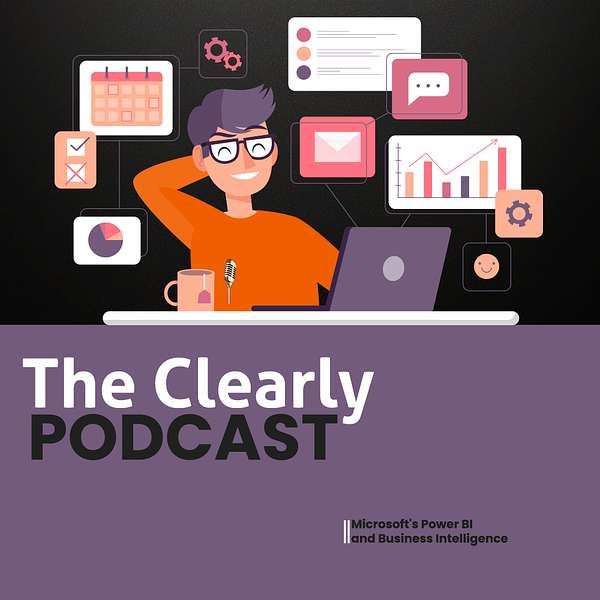
The Clearly Podcast
The Clearly Podcast
Power Apps and Power Pages- Demystifying the Options
Welcome to the Clearly Podcast, where today's discussion focuses on Power Apps, particularly canvas apps, model-driven apps, and Power Pages, and how to choose the right one.
Power Pages are ideal for external, infrequent users due to their pricing model and ability to handle large user bases. In contrast, canvas and model-driven apps are more suited for internal use. Canvas apps offer high customization and a user-friendly mobile interface, making them great for tasks like inventory logging. However, they require careful management to avoid becoming overly complex. Model-driven apps, which are form-based and linked to Microsoft CRM, are faster to set up and better for structured, transactional tasks but are limited to using Dataverse.
Client discussions typically start by identifying the project’s goals, budget, and timeline, prioritizing essential features, and planning additional phases. Managing expectations is crucial to prevent overcomplicating the project.
When choosing data sources for canvas apps, Dataverse is preferred, but budget constraints might lead to using SharePoint lists, which must be managed carefully to avoid data issues. Deciding on data storage upfront is essential to avoid complications later.
Power Pages are low-code environments suitable for creating external portals without needing individual licenses, making them ideal for customer portals. They support both authenticated and unauthenticated users and are priced based on usage.
Clients often start using Power Apps by transitioning from cumbersome Excel spreadsheets to improve data management and security. Demonstrating practical examples helps clients understand the benefits.
Long-term care and maintenance of Power Apps involve planning for support, ensuring sufficient storage, and considering future improvements. A support plan can be more cost-effective than hiring full-time staff and ensures ongoing maintenance.
Power Apps are an investment requiring ongoing care and development. Thank you for joining the discussion, and we look forward to the next episode.
Andy:
Welcome to the Clearly Podcast. I'm Andy Clark.
Tom:
I'm Tom Gough.
Shailan:
And I'm Shailan, also known as Terry Hughes.
Andy:
Great to have you, Terry. Today, we'll discuss Power Apps, focusing on canvas apps, model-driven apps, and Power Pages, helping you decide which to use.
Tom:
I'll be quieter today since this is more Terry and Andy’s expertise.
Andy:
So, let's dive in. Terry, how do you approach differentiating between canvas apps, model-driven apps, and Power Pages?
Shailan:
Power Pages are unique, mostly for external, infrequent users. Canvas and model-driven apps are more common choices, typically for internal systems.
Andy:
Exactly. How do client discussions about choosing the right Power App usually start?
Shailan:
It depends. For example, a client wanted Power Pages but later realized Power Apps were better. The main difference between Power Apps and Power Pages is the number of users. Power Pages are for many users, while Power Apps are more suitable for internal systems with fewer users.
Andy:
That's right. Let's discuss canvas versus model-driven apps. How do you decide which to recommend?
Shailan:
Canvas apps offer more customization and are user-friendly for mobile devices. Model-driven apps are form-based, linked to Microsoft CRM, and quicker to set up. They work well for transactional data and can only use Dataverse.
Andy:
Good points. I’ve found model-driven apps are great for structured, transactional tasks, like managing contracts. Canvas apps are better for flexible, customizable solutions.
Shailan:
Agreed. Canvas apps are highly customizable, suitable for tasks like inventory logging. They offer a more user-friendly interface but require careful management to avoid overcomplication.
Andy:
Managing client expectations is crucial. We often start with a minimum viable product and add features over time. How do you manage client expectations?
Shailan:
Discuss the project’s goals, budget, and timeline. Prioritize must-have features and plan phases for additional features to avoid endless improvements.
Tom:
Also, remind clients that Power Apps are chosen for quick, cost-effective solutions. Overcomplicating requirements can make development as time-consuming as traditional coding.
Andy:
Good point, Tom. Terry, how do you handle data sources for canvas apps?
Shailan:
We consider current data sources and client preferences. Dataverse is preferred, but budget constraints might lead to using SharePoint lists. However, SharePoint lists should be carefully managed to avoid data issues.
Tom:
It's essential to decide on data storage upfront to avoid complications later.
Andy:
Exactly. Let's talk about Power Pages. Terry, can you explain their use?
Shailan:
Power Pages are low-code environments for external users, often compared to websites. They support authenticated and unauthenticated users and are priced based on usage, making them ideal for customer portals.
Tom:
They work well for creating external portals without needing individual licenses, offering flexible access management.
Andy:
Would you use Power Pages for internal users?
Shailan:
Yes, in some cases, like hospitals with many staff members. Power Pages can be more cost-effective than Power Apps licenses.
Andy:
How do clients typically start using Power Apps?
Shailan:
I demonstrate our demo apps and discuss potential solutions. Showing clients practical examples helps them understand the benefits.
Andy:
I often transition clients from cumbersome Excel spreadsheets to Power Apps for better data management and security.
Tom:
Yes, shifting from Excel to Power Apps can significantly improve efficiency and data integrity.
Andy:
Finally, let’s discuss long-term care and maintenance of Power Apps. What should clients consider?
Shailan:
Clients should plan for long-term support, possibly with a support plan, and ensure their apps have sufficient storage. Keeping the app updated and considering phase two improvements is essential.
Tom:
A support plan can be more cost-effective than hiring full-time support staff and ensures ongoing maintenance and improvements.
Andy:
Power Apps are an investment, requiring ongoing care and development. On that note, thanks, everyone, for the great discussion. We’ll be back next week with another topic.
Tom:
Thank you. Bye!
Shailan:
Goodbye!